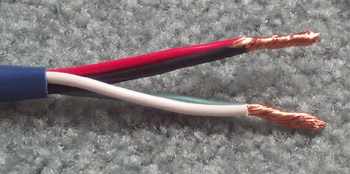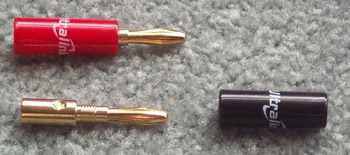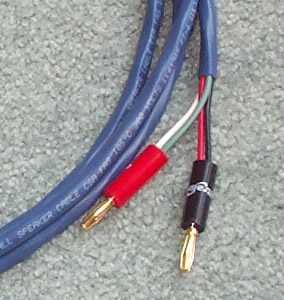|
||||||||||||||||
|
A Practical Realist I have no aversion to high prices, even though I myself am in no position to own the most expensive pieces of AV gear. I respect the laws of diminishing returns, acknowledging that as performance continues to increase marginally, price increases exponentially. To Meridian, one of the most expensive names in the business, I give my particular approval. They're genuinely innovative and at the head of the audio industry, and if you want the cutting edge in available technology, they're one of the best. What I do have a problem with, and take the gravest of exception to, is the myriad of voodoo, smoke and mirror marketing which strives to justify the existence of so many high priced AV products. Therefore, I seek out high performance which is truly such, and not that which simply costs more. I believe true high end performance is achievable without taking out a loan. I want what is practical, and what is real. And Then There is Cable Believe what you want, spend what you like, but for me and mine, we'll steer clear of exotic AV cable. I'm about to put together a speaker cable that just plain works and costs about a dollar a foot. If you can believe such a thing will perform, this review is for you. Recently I became enamored with M&K speakers (to the point of buying one of their subwoofers for myself). What really had me hooked is their no-nonsense, total lack of BS. They make speakers which reproduce the signal with a ruler flat response, not just in frequency but in the time domain as well (i.e., transient response), and they make sure it does that at all output levels. The Pro Market, especially those in post production, love M&K speakers and subs. But take a look at the back of any M&K speaker. There is one set of binding posts. M&K does not believe in bi-wiring, the benefits of which were dubious to me anyway. If you break it down into simple electronic theory, the only "benefit" possible with bi-wiring is theoretically more output at the crossover region (between the posts) if you've got long runs of high resistance cable, but I don't think that could be considered a benefit. As for passive bi-amplification, the benefits, with some amplifiers, can be substantial, although only due to shortcomings of those amplifiers. Passive bi-amping can do little to increase the total voltage applied to the speaker, though it will relieve each individual amp of some current draw. (Note: active bi-amping, as found inside of active speakers and better movie theaters, is a completely different and wonderful thing as outlined in our article on the subject). Bearing all this in mind, I started to ponder the question, "What would M&K, bosses of no BS, use for speaker cable?" They do "strongly recommend" (their exact phrase) that their customers use the heaviest gauge of speaker cable they can, noting that M&K's binding posts will accept a 4 gauge wire! They also warn about cost not necessarily equating to performance when it comes to cable. Of course, that applies to any product, in the A/V world and elsewhere. Well, that at least gives us something to go on. Fellow Secrets Editor Colin Miller and I exchanged e-mails on the topic of cable characteristics and figured out what was desirable for a speaker cable and how we could cheaply . . . I mean, simply achieve it. Colin, feel free to jump in . . . . Cable Electrical Factors and How They Affect the Sound - Colin Miller When
talking about cable characteristics, we can boil it down to the sacred
trinity of L/C/R: Inductance (L in henries), Capacitance (C in farads), and Resistance (R in ohms). Resistance is a DC component, and is called resistive impedance. Inductance and capacitance are AC components, and are called reactive impedance. Capacitance is a parallel impedance factor in a cable. The impedance of a capacitor
falls as frequency rises. If you took a tiny capacitor and put it in
parallel with your loudspeaker terminals, it would reduce the bass. That is why they are used with tweeters in crossover networks. If
it were a big enough capacitor, your amplifier would have a hissy fit, drive
tons of current through it at high frequencies (as it'd look like a short),
and smoke or blow a fuse. Except for long runs of exotic cables with
lots of individually insulated conductors connected to
inherently unstable amplifiers, there's not enough capacitance in a hundred
feet of speaker cable to make any competent amplifier raise an eyebrow. Keep
in mind that the idea of doubling up on 14 gauge conductors for speakers only works when
you bind two conductors together at each end. If you keep them separate on
the loudspeaker side, as would be done when you bi-wire a speaker, the
benefits described are forfeit, as you only have one cable in series with
any given crossover section at a time! In other words, you’ve got the same
resistance and inductance in series with a given driver section, but are
still using twice the wire, AND have twice the capacitance of a single run.
Sound like a good deal? Want to buy the Brooklyn bridge? Brian, build us a cable why don't you?
Shortly after my solicitation for review sample, a box showed up with 30 feet of Ultralink CL414 cable, enough to make three pairs of 10 foot speaker cables for my front three channels. The CL414 is a straight up copper speaker wire. No nonsense, just what we want. The conductor is quoted as 99.9999% oxygen free copper (OFC). This is also called 6N copper (as in 6 nines - 99.9999% OFC). 6N copper costs more than pure silver - even in the huge quantities that Ultralink buys to make their cables, and many of us feel it (6N copper) is the best choice as an audio conductor. Relatively speaking, in the CL414 we've got a lot of 6N copper for a fraction of the cost of most brand name speaker cable. Four differently colored 14 gauge wires are twisted inside a PVC jacket. You might say, "PVC is not a great dielectric". True, it will have more capacitance than, say, Teflon or foamed polyethylene. So, don't use it for an audio interconnect. This is a loudspeaker application though, so we don't really care. The jacket is key here. The idea of doubling up on 14 gauge wire could be done with "normal" speaker wire, but that would look a little messy. The In-Wall stuff gives us what we're after in a neat jacket which in the case of Ultralink is nice and flexible, and flexible is always welcome in my overwired world. If you end up liking this wire, you'll probably want to use it with your surrounds too and, it's already UL/CSA approved for in-wall use. The flexible jacket is a boon when passing the cable through tight spaces, and being so called "virgin" PVC, its actually quite slick, again good for feeding it through tight spaces.
Making sure a cable has a good connection at either end is in all practicality as important as the cable itself, maybe even more so. If you've got the guts to refute the snickering of hi-fi snobs, and both your amplifier and speakers have robust binding posts, you could just stick the bare wire in them and come on to that fastening nut with all your might. Maybe put a drop or two of Caig's Pro Gold on the wire just to stave off oxidation. In my position as a reviewer, I appreciate the cable end that makes it easy to swap gear, i.e., having the proverbial banana. Ultralink has a whole range of bananas to choose from, but I'll highlight the UL0534 for a couple reasons. It's very affordable and putting it on the end of a cable takes virtually no skill. The wire is held in place by two offset micro screws on the barrel. A crimp and solder type banana (of course Ultralink happens to have one) would make the "best" connection between wire and terminator, but that requires a pretty hefty soldering iron and some skill. Plus, with the screws, if you want to try a different wire, or you need a longer piece down the road, you can reuse your investment in these ends. The bananas have pure 24K gold plated directly to the conductor, without the nickel substrate that many others use. A nickel substrate makes the gold a bit "golder" and shinier but introduces a layer of differing resistance from a material that, like iron and cobalt, is ferrous and therefore magnetic (and the word "magnetic" is one we don't ever want to see in a cable). I was pleasantly surprised by how snug these bananas were when I plugged them into the amp and speakers. To look at them you would not think so, but they hold on pretty tight.
There is nothing to constructing these cables other than paying strict attention to the fact that this is not a bi-wire cable! Do not be tempted to get an extra set of bananas at the speaker end just to make use of the bi-wire posts on your speaker. As Colin already told us, that would ruin what we are trying to do here. If you can't help yourself, at least leave the shorting straps on the speaker in place. You'll then have the "cool" look of bi-wire with the benefits of our little design. You will need a small screw driver so that you can fasten the wire tightly. I actually warped my el-cheapo screw driver when putting these together. Want to get snazzy? Get a little heat-shrink tubing to tidy up the pairs at each end. Slip the heat shrink stuff on before you attach the terminations. If you expect a religious experience with any cable, you'll probably talk yourself into having one here, and I sincerely hope you enjoy it. No, the soundstage did not open up for me, veils of detail were not revealed, the midrange did not bloom with extra life, the bottom end did not suddenly become more robust and defined. Frankly, I jolly well hoped none of that poetic drivel would happen! If it had, that would mean the cable I've been using for the past three years sucks big time. Instead what I found was no objection whatsoever. My speakers sounded as clean as I have ever heard them, and the power amplifiers of my receiver seemed unimpeded, able to hit reference level without any distress or aberrations in the sound. Conclusions This cable does what a speaker cable needs to do: It just plain works. There is nothing "remarkable" about the sound (that's a good thing), and the bananas make a solid connection. While much of the brand name cable market seems content to create an exorbitant expense for us by supplying a mix and match game of cables which are more "filter" than anything else, we feel that an unremarkable cable (in terms of sound) is what we should be after, and Ultralink seems to share that view. They do make a bevy of more expensive cable. Such things as Teflon dielectric, silver coatings, and other features do appeal to many consumers. If you can hear a difference with those features, be my guest. If on the other hand the back-to-basics approach appeals to you, this semi DYI cable performs, looks cool, is easy to assemble (no assembly at all if you forgo the terminators), and costs less than a buck a foot, yet is still sophisticated. In fact, unless they've read this review, I'll bet anyone who tries this cable will think it is a multi-hundred dollar "premium esoteric". Post-Script On a somewhat related and interesting note, I recently asked the Cinesphere what they use for speaker wire. Cinesphere is the world's first permanent IMAX® facility, and IMAX® represents the finest available in terms of commercial motion picture and multi-channel sound. Their wire of choice: Four 10 gauge stranded wires, twisted together, for each run. In other words, the exact same configuration as our cable, only "upsized" for the their long runs (which at Cinesphere are about 100 feet).
|
||||||||||||||||


 In-Wall Cable . . . Outside
the Wall
In-Wall Cable . . . Outside
the Wall Terminate This!
Terminate This! Presto: Speaker Cable
Presto: Speaker Cable

